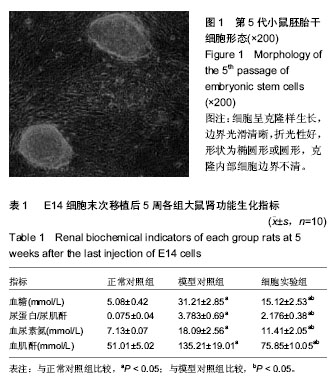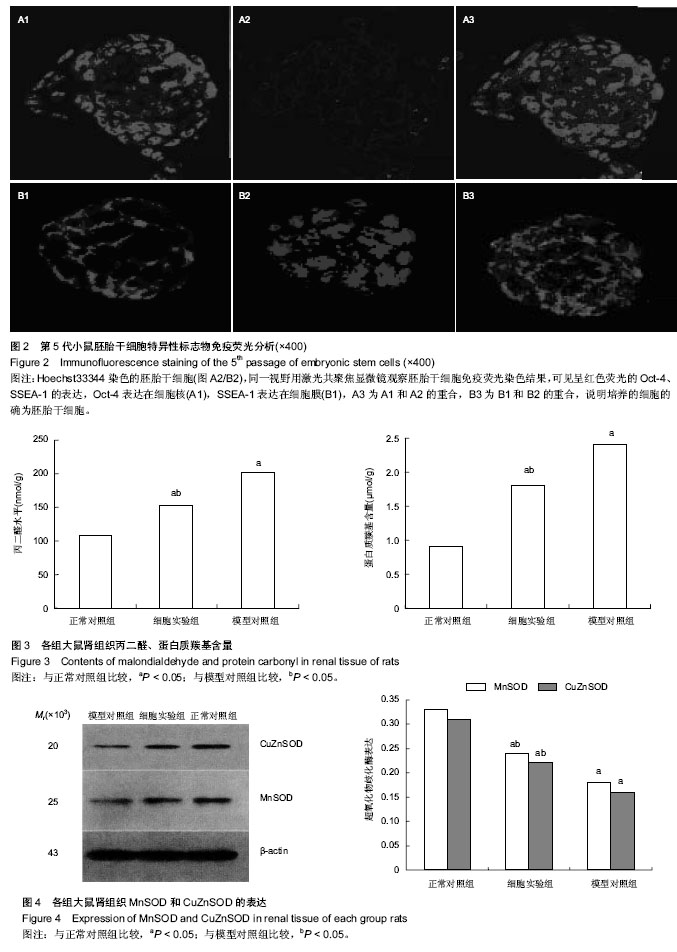| [1] Forbes JM, Coughlan MT, Cooper ME.Oxidative stress as a major culprit in kidney disease in diabetes.Diabetes. 2008; 57(6):1446-1454.
[2] Chen YT, Sun CK, Lin YC, et al. Adipose-derived mesenchymal stem cell protects kidneys against ischemia- reperfusion injury through suppressing oxidative stress and inflammatory reaction. J Transl Med. 2011;9:51.
[3] Tögel F, Hu Z, Weiss K, et al. Administered mesenchymal stem cells protect against ischemic acute renal failure through differentiation-independent mechanisms.Am J Physiol Renal Physiol. 2005;289(1):F31-42.
[4] Han SY, Jee YH, Han KH, et al. An imbalance between matrix metalloproteinase-2 and tissue inhibitor of matrix metalloproteinase-2 contributes to the development of early diabetic nephropathy. Nephrol Dial Transplant. 2006;21(9): 2406-2416.
[5] Hasan NA. Effects of trace elements on albumin and lipoprotein glycation in diabetic retinopathy. Saudi Med J. 2009;30(10):1263-1271.
[6] Nam SM, Lee MY, Koh JH, et al. Effects of NADPH oxidase inhibitor on diabetic nephropathy in OLETF rats: the role of reducing oxidative stress in its protective property. Diabetes Res Clin Pract. 2009;83(2):176-182.
[7] Rossant J.Stem cells from the Mammalian blastocyst.Stem Cells. 2001;19(6):477-482.
[8] Pal R. Embryonic stem (ES) cell-derived cardiomyocytes: a good candidate for cell therapy applications. Cell Biol Int. 2009;33(3):325-336.
[9] Hipp J, Atala A. Sources of stem cells for regenerative medicine. Stem Cell Rev. 2008;4(1):3-11.
[10] Yang W, Lu J, Weng J, et al. Prevalence of diabetes among men and women in China. N Engl J Med. 2010;362(12): 1090-1101.
[11] Volarevic V, Arsenijevic N, Lukic ML, et al. Concise review: Mesenchymal stem cell treatment of the complications of diabetes mellitus.Stem Cells. 2011;29(1):5-10.
[12] Stolzing A, Sellers D, Llewelyn O, et al. Diabetes induced changes in rat mesenchymal stem cells. Cells Tissues Organs. 2010;191(6):453-465.
[13] Zhang L, Wang F, Wang L, et al. Prevalence of chronic kidney disease in China: a cross-sectional survey. Lancet. 2012;379 (9818):815-822.
[14] Marchant K. Diabetes and chronic kidney disease: a complex combination. Br J Nurs. 2008;17(6):356-361.
[15] 李龙,杨明正,周忠启,等.阿托伐他汀对糖尿病大鼠肾脏保护作用及其机制探讨[J].中国病理生理杂志,2006,22(10):2059-2061.
[16] Monagas M, Quintanilla-López JE, Gómez-Cordovés C, et al. MALDI-TOF MS analysis of plant proanthocyanidins. J Pharm Biomed Anal. 2010;51(2):358-372.
[17] Busik JV, Tikhonenko M, Bhatwadekar A,et al. Diabetic retinopathy is associated with bone marrow neuropathy and a depressed peripheral clock. J Exp Med. 2009;206(13):2897- 2906.
[18] Ishizuka T, Hinata T, Watanabe Y. Superoxide induced by a high-glucose concentration attenuates production of angiogenic growth factors in hypoxic mouse mesenchymal stem cells. J Endocrinol. 2011;208(2):147-159.
[19] Secchiero P, Melloni E, Corallini F, et al. Tumor necrosis factor-related apoptosis-inducing ligand promotes migration of human bone marrow multipotent stromal cells. Stem Cells. 2008;26(11):2955-2963.
[20] Corallini F, Secchiero P, Beltrami AP, et al. TNF-alpha modulates the migratory response of mesenchymal stem cells to TRAIL.Cell Mol Life Sci. 2010;67(8):1307-1314.
[21] Steffes MW, Brown DM, Mauer SM. Diabetic glomerulopathy following unilateral nephrectomy in the rat. Diabetes. 1978; 27(1):35-41.
[22] Lin G, Wang G, Liu G, et al. Treatment of type 1 diabetes with adipose tissue-derived stem cells expressing pancreatic duodenal homeobox 1. Stem Cells Dev. 2009;18(10): 1399-1406.
[23] 程庆砾,齐云,马强,等. 骨髓干细胞在小鼠糖尿病性肾脏疾病表型转移中的作用[J].中国糖尿病杂志,2011,19(10):777-780.
[24] 周虹,高赟,田浩明.骨髓间充质干细胞治疗大鼠糖尿病肾病初探[J].四川大学学报:医学版,2009,40(6):1024-1028.
[25] Ezquer FE, Ezquer ME, Parrau DB, et al. Systemic administration of multipotent mesenchymal stromal cells reverts hyperglycemia and prevents nephropathy in type 1 diabetic mice. Biol Blood Marrow Transplant. 2008;14(6): 631-640.
[26] Oudot C, Lajoix AD, Jover B, et al. Oxydative stress and beneficial effect of sodium restriction on kidney damage associated with insulin resistance in rats. Ann Cardiol Angeiol (Paris). 2012;61(3):162-166.
[27] Bhattacharya S, Manna P, Gachhui R, et al. D-saccharic acid-1,4-lactone ameliorates alloxan-induced diabetes mellitus and oxidative stress in rats through inhibiting pancreatic β-cells from apoptosis via mitochondrial dependent pathway. Toxicol Appl Pharmacol. 2011;257(2): 272-283.
[28] Naruse R, Suetsugu M, Terasawa T, et al. Oxidative stress and antioxidative potency are closely associated with diabetic retinopathy and nephropathy in patients with type 2 diabetes. Saudi Med J. 2013;34(2):135-141.
[29] Fang Y, Tian X, Bai S, et al. Autologous transplantation of adipose-derived mesenchymal stem cells ameliorates streptozotocin-induced diabetic nephropathy in rats by inhibiting oxidative stress, pro-inflammatory cytokines and the p38 MAPK signaling pathway. Int J Mol Med. 2012;30(1): 85-92.
[30] Li H, Zuo S, He Z, et al. Paracrine factors released by GATA-4 overexpressed mesenchymal stem cells increase angiogenesis and cell survival. Am J Physiol Heart Circ Physiol. 2010;299(6):H1772-1781.
[31] Khan M, Akhtar S, Mohsin S, et al. Growth factor preconditioning increases the function of diabetes-impaired mesenchymal stem cells. Stem Cells Dev. 2011;20(1):67-75.
[32] Yoh K, Hirayama A, Ishizaki K, et al. Hyperglycemia induces oxidative and nitrosative stress and increases renal functional impairment in Nrf2-deficient mice. Genes Cells. 2008;13(11): 1159-1170. |


.jpg)